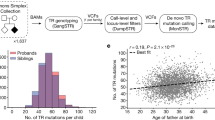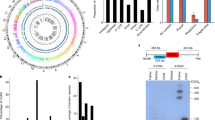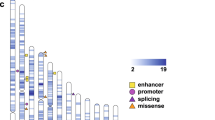Abstract
Autism is a complex neurodevelopmental disorder with severe cognitive and communication disabilities, that has a strong genetic predisposition.1 Reelin, a protein involved in neuronal migration during development, is encoded by a gene located on 7q22,2 within the candidate region on 7q showing increased allele sharing in previous genome scans.3–8 A case/control and family-based association study recently reported a positive association between a trinucleotide repeat polymorphism (GGC) located in the 5′ untranslated region (UTR) of the reelin gene and autism.9 We performed a transmission disequilibrium test (TDT) analysis of the 5′UTR polymorphism in 167 families including 218 affected subjects (117 trios and 50 affected sib pairs) and found no evidence of linkage/association. Our results do not support previous findings and suggest that this GGC polymorphism of the reelin gene is unlikely to be a major susceptibility factor in autism and/or genetic heterogeneity.
This is a preview of subscription content, access via your institution
Access options
Subscribe to this journal
Receive 12 print issues and online access
$259.00 per year
only $21.58 per issue
Buy this article
- Purchase on Springer Link
- Instant access to full article PDF
Prices may be subject to local taxes which are calculated during checkout
Similar content being viewed by others
References
Lamb JA, Moore J, Bailey A, Monaco AP . Autism: recent molecular genetic advances Hum Mol Genet 2000; 9: 861–868
DeSilva U, D'Arcangelo G, Braden VV, Chen J, Miao GG, Curran T et al. The human reelin gene: isolation, sequencing, and mapping on chromosome 7 Genome Res 1997; 7: 157–164
International Molecular Genetic Study of Autism Consortium. A full genome screen for autism with evidence for linkage to a region on chromosome 7q Hum Mol Genet 1998; 7: 571–578
Philippe A, Martinez M, Guilloud-Bataille M, Gillberg C, Rastam M, Sponheim E et al. Genome-wide scan for autism susceptibility genes. Paris Autism Research International Sibpair Study Hum Mol Genet 1999; 8: 805–812
Ashley-Koch A, Wolpert CM, Menold MM, Zaeem L, Basu S, Donnelly SL et al. Genetic studies of autistic disorder and chromosome 7 Genomics 1999; 61: 227–236
Barrett S, Beck JC, Bernier R, Bisson E, Braun TA, Casavant TL et al. An autosomal genomic screen for autism. Collaborative linkage study of autism Am J Med Genet 1999; 88: 609–615
Buxbaum JD, Silverman JM, Smith CJ, Kilifarski M, Reichert J, Hollander E et al. Evidence for a susceptibility gene for autism onchromosome 2 and for genetic heterogeneity Am J Hum Genet 2001; 68: 1514–1520
International Molecular Genetic Study of Autism Consortium. A genomewide screen for autism: strong evidence for linkage to chromosomes 2q, 7q, and 16p Am J Hum Genet 2001; 69: 570–581
Persico AM, D'Agruma L, Maiorano N, Totaro A, Militerni R, Bravaccio C et al. Reelin gene alleles and haplotypes as a factor predisposing to autistic disorder Mol Psychiatry 2001; 6: 150–159
Bailey A, Le Couteur A, Gottesman I, Bolton P, Simonoff E, Yuzda E et al. Autism as a strongly genetic disorder: evidence from aBritish twin study Psychol Med 1995; 25: 63–77
Steffenburg S, Gillberg C, Hellgren L, Andersson L, Gillberg IC, Jakobsson G et al. A twin study of autism in Denmark, Finland, Iceland, Norway and Sweden J Child Psychol Psychiatry 1989; 30: 405–416
Ritvo ER, Jorde LB, Mason-Brothers A, Freeman BJ, Pingree C, Jones MB et al. The UCLA-University of Utah epidemiologic survey of autism: recurrence risk estimates and genetic counseling Am J Psychiatry 1989; 146: 1032–1036
Pickles A, Bolton P, Macdonald H, Bailey A, Le Couteur A, Sim CH et al. Latent-class analysis of recurrence risks for complex phenotypes with selection and measurement error: a twin and family history study of autism Am J Hum Genet 1995; 57: 717–726
Risch N, Spiker D, Lotspeich L, Nouri N, Hinds D, Hallmayer J et al. A genomic screen of autism: evidence for a multilocus etiology Am J Hum Genet 1999; 65: 493–507
Liu J, Nyholt DR, Magnussen P, Parano E, Pavone P, Geschwind D et al. A genomewide screen for autism susceptibility loci Am J Hum Genet 2001; 69: 327–340
Teitelbaum P, Teitelbaum O, Nye J, Fryman J, Maurer RG . Movement analysis in infancy may be useful for early diagnosis of autism Proc Natl Acad Sci USA 1998; 95: 13982–13987
Courchesne E . Brainstem, cerebellar and limbic neuroanatomical abnormalities in autism Curr Opin Neurobiol 1997; 7: 269–278
Bailey A, Luthert P, Dean A, Harding B, Janota I, Montgomery M et al. A clinicopathological study of autism Brain 1998; 121: 889–905
Fatemi SH . Reelin mutations in mouse and man: from reeler mouse to schizophrenia, mood disorders, autism and lissencephaly Mol Psychiatry 2001; 6: 129–133
Fatemi SH, Earle JA, McMenomy T . Reduction in Reelin immunoreactivity in hippocampus of subjects with schizophrenia, bipolar disorder and major depression Mol Psychiatry 2000; 5: 654–663
Guidotti A, Auta J, Davis JM, Gerevini VD, Dwivedi Y, Grayson DR et al. Decrease in reelin and glutamic acid decarboxylase67 (GAD67) expression in schizophrenia and bipolar disorder: a postmortem brain study Arch Gen Psychiatry 2000; 57: 1061–1069
Hong SE, Shugart YY, Huang DT, Shahwan SA, Grant PE, Hourihane JO et al. Autosomal recessive lissencephaly with cerebellar hypoplasia is associated with human RELN mutations Nat Genet 2000; 26: 93–96
Rice DS, Curran T . Mutant mice with scrambled brains: understanding the signaling pathways that control cell positioning in the CNS Genes Dev 1999; 13: 2758–2773
Sham PC, Curtis D . An extended transmission/disequilibrium test (TDT) for multi-allele marker loci Ann Hum Genet 1995; 59: 323–336
Ohshima T, Ogawa M, Veeranna, Hirasawa M, Longenecker G, Ishiguro K et al. Synergistic contributions of cyclin-dependant kinase 5/p35 and Reelin/Dab1 to the positioning of cortical neurons in the developing mouse brain Proc Natl Acad Sci USA 2001; 98: 2764–2769
Sheldon M, Rice DS, D'Arcangelo G, Yoneshima H, Nakajima K, Mikoshiba K et al. Scrambler and yotari disrupt the disabled gene and produce a reeler-like phenotype in mice Nature 1997; 389: 730–733
Hiesberger T, Trommsdorff M, Howell BW, Goffinet A, Mumby MC, Cooper JA et al. Direct binding of Reelin to VLDL receptor and ApoE receptor 2 induces tyrosine phosphorylation of disabled-1 and modulates tau phosphorylation Neuron 1999; 24: 481–489
Mallamaci A, Mercurio S, Muzio L, Cecchi C, Pardini CL, Gruss P et al. The lack of Emx2 causes impairment of Reelin signaling and defects of neuronal migration in the developing cerebral cortex J Neurosci 2000; 20: 1109–1118
Ringstedt T, Linnarsson S, Wagner J, Lendahl U, Kokaia Z, Arenas E et al. BDNF regulates reelin expression and Cajal–Retzius cell development in the cerebral cortex Neuron 1998; 21: 305–315
Lord C, Rutter M, Le Couteur A . Autism Diagnostic Interview-Revised: a revised version of a diagnostic interview for caregivers of individuals with possible pervasive developmental disorders J Autism Dev Disord 1994; 24: 659–685
Acknowledgements
We thank the patients and their families who made this research possible. This work was supported by the INSERM, the Assistance Publique-Hopitaux-de-Paris (PHRC AOM95076 and CRC No. 932413), and the Swedish Medical Research Council (grant No. K97-21X-11251-03CK). SL received financial support from Pfizer France (‘Project Cabanis’). We are grateful to Christiane Penet, Yolaine Pothin, and Jacqueline Bou for technical assistance at the DNA and cell bank from the INSERM U289 (IFR des Neurosciences, Hôpital Pitié-Salpêtrière) and to Nathalie Griffon (INSERM U109).
Author information
Authors and Affiliations
Author notes
Paris Autism Research International Sibpair Study: France. Department of Psychiatry, Hôpital Albert Chenevier et Henri Mondor, Créteil: Marion Leboyer, Anne Philippe; INSERM U513, Faculté de Médecine, Créteil: Catalina Betancur; Service de Psychopathologie de l'Enfant et l'Adolescent, Hôpital Robert Debré, Paris: Catherine Colineaux, Nadia Chabane, Marie-Christine Mouren-Siméoni; INSERM U289, Hôpital de la Salpétrière, Paris: Alexis Brice. Sweden. Department of Child and Adolescent Psychiatry, Göteborg University, Göteborg: Christopher Gillberg, Maria Råstam, Carina Gillberg, Agneta Nydén. Norway. Centre for Child and Adolescent Psychiatry, University of Oslo, Oslo: Eili Sponheim, Ingrid Spurkland; Department of Pediatrics, Rikshospitalet, University of Oslo, Oslo: Ola H Skjeldal. USA. Department of Pediatrics, Georgetown University School of Medicine, Washington DC: Mary Coleman; Children's National Medical Center, George Washington University School of Medicine, Washington, DC: Philip L Pearl; New York State Institute for Basic Research in Developmental Disabilities, Staten Island, New York: Ira L Cohen, John Tsiouris. Italy. Divisione di Neuropsichiatria Infantile, Azienda Ospedaliera Senese, Siena: Michele Zappella, Grazia Menchetti, Alfonso Pompella. Austria. Department of General Psychiatry, University Hospital, Vienna: Harald Aschauer. Belgium. Centre de Génétique Humaine, Institut de Pathologie et de Génétique, Gerpinnes, Loverval: Lionel Van Maldergem.
Consortia
Corresponding author
Rights and permissions
About this article
Cite this article
Krebs, M., Betancur, C., Leroy, S. et al. Absence of association between a polymorphic GGC repeat in the 5′ untranslated region of the reelin gene and autism. Mol Psychiatry 7, 801–804 (2002). https://doi.org/10.1038/sj.mp.4001071
Received:
Accepted:
Published:
Issue Date:
DOI: https://doi.org/10.1038/sj.mp.4001071
Keywords
This article is cited by
-
Genetische und hirnstrukturelle Anomalien bei Autismus-Spektrum-Störungen
Der Nervenarzt (2011)
-
The genetics of autistic disorders and its clinical relevance: a review of the literature
Molecular Psychiatry (2007)
-
A heterogeneity-based genome search meta-analysis for autism-spectrum disorders
Molecular Psychiatry (2006)
-
Identification of novel autism candidate regions through analysis of reported cytogenetic abnormalities associated with autism
Molecular Psychiatry (2006)



